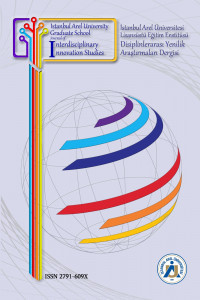Bir sekiz buçuk sendromu olgusu: pontin laküner infarktın nadir bir prezentasyonu
Sekiz buçuk sendromu, bir buçuk sendromu [konjuge yatay bakış felci ve internükleer oftalmopleji (INO)], artı ipsilateral kraniyal sinir yedinci (CN VII) felcidir. Bu nadir sendrom, abdusens nükleusu içeren, ipsilateral medial longitudinal fasciculus (MLF) ve fasiyal kollikulusu tutan pontin tegmentum lezyonları sebebiyle meydana gelir. Bu olguda binoküler horizontal diplopi ile hastanemize başvuran ve sonrasında sekiz buçuk sendromu tanısı alan 68 yaşında bir erkek hastayı sunmaktayız. Sekiz buçuk sendromu nadir olmakla birlikte, aynı anda hem diplopi hem de periferik yüz felci olan hastalar da akılda tutulmalıdır.
Anahtar Kelimeler:
diplopi, internükleer oftalmopleji, fasiyal palsi, abdusens nükleusu, nistagmus
An eight-and-a-half syndrome case: a rare presentation of pontine lacunar infarction
The eight-and-a-half syndrome is a one-and-a-half syndrome [conjugated horizontal gaze palsy and internuclear ophthalmoplegia (INO)], plus an ipsilateral cranial nerve seventh (CN VII) palsy. This rare syndrome is caused by the pontine tegmentum's lesions involving the abducens nucleus, the ipsilateral medial longitudinal fasciculus (MLF), and the facial colliculus. In this case, we report a 68-year-old male patient admitted to our hospital with binocular horizontal diplopia later diagnosed with the eight-and-a-half syndrome. Although the eight-and-a-half syndrome is rare, it should be kept in mind with patients presenting diplopia and peripheral facial palsy simultaneously.
Keywords:
diplopia, internuclear ophthalmoplegia, facial palsy, abducens nucleus, nystagmus,
___
- [1] Kumar NSS, Raju CG, Kiran PR et al. “Eight-and-a-Half Syndrome: A Rare Presentation of Pontine Infarction”. Journal of Stroke and Cerebrovascular Diseases, 23(8), e389-e391, 2014.
- [2] Frohman TC, Galetta S, Fox R, et al. “Pearls & Oy-sters: The medial longitudinal fasciculus in ocular motor physiology”. Neurology, 70(17), e57-e67, 2008.
- [3] Keane JR. “Internuclear Ophthalmoplegia: Unusual Causes in 114 of 410 Patients.” Arch Neurol, 62(5), 714–717, 2005.
- [4] Wu YT, Cafiero‐Chin M, Marques C. “Wall‐eyed bilateral internuclear ophthalmoplegia”. Clinical and Experimental Optometry, 98(1), 25-30, 2015.
- Yayın Aralığı: Yılda 2 Sayı
- Başlangıç: 2021
- Yayıncı: İstanbul Arel Üniversitesi
Sayıdaki Diğer Makaleler
Kullanıcı deneyimini anlamada kolaj yöntemi: reklamcılık ve organizasyondaki uygulaması
Erzincan örneğinde varlıklı sınıfın şehrin kalkınmasına kısıtlı katkısı
Mustafa Şeref AKIN, Ebubekir KARADAŞ
Ciddi akut solunum sendromu koronavirüs 2 enfeksiyonunda simetrik periferik polinöropati
Ufuk ÇINKIR, Saltanat MERT, Ayhan KÖKSAL
Endonezya jeopolitiğinde “Nusantara” kavramı
İklim değişikliği ve su kaynakları olgusunun posta pulları üzerinden değerlendirilmesi
Din, inanç ve ahlak bağlamında yenilikçi ekonomilere nasıl yaklaşılır?
Bir sekiz buçuk sendromu olgusu: pontin laküner infarktın nadir bir prezentasyonu
